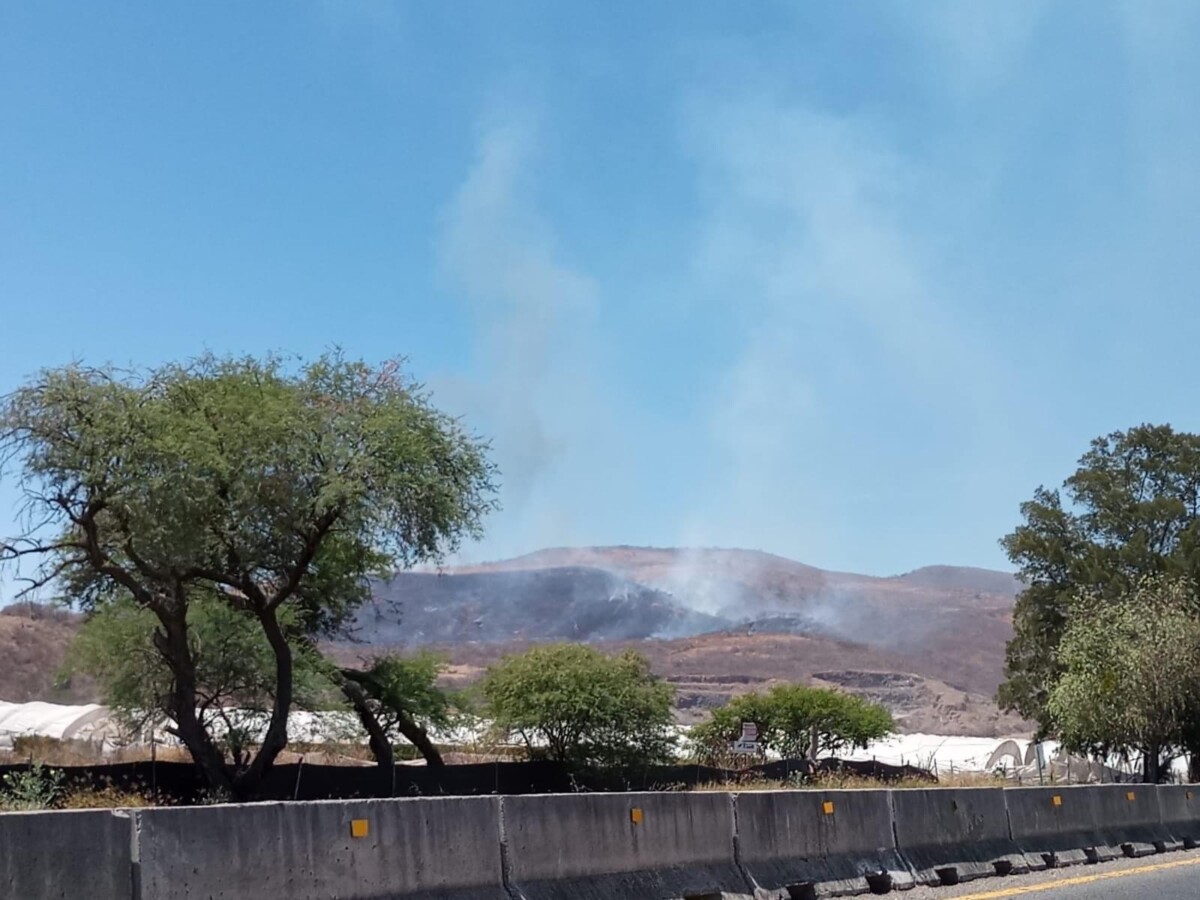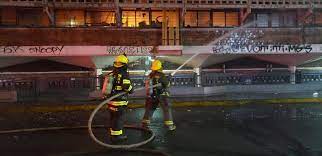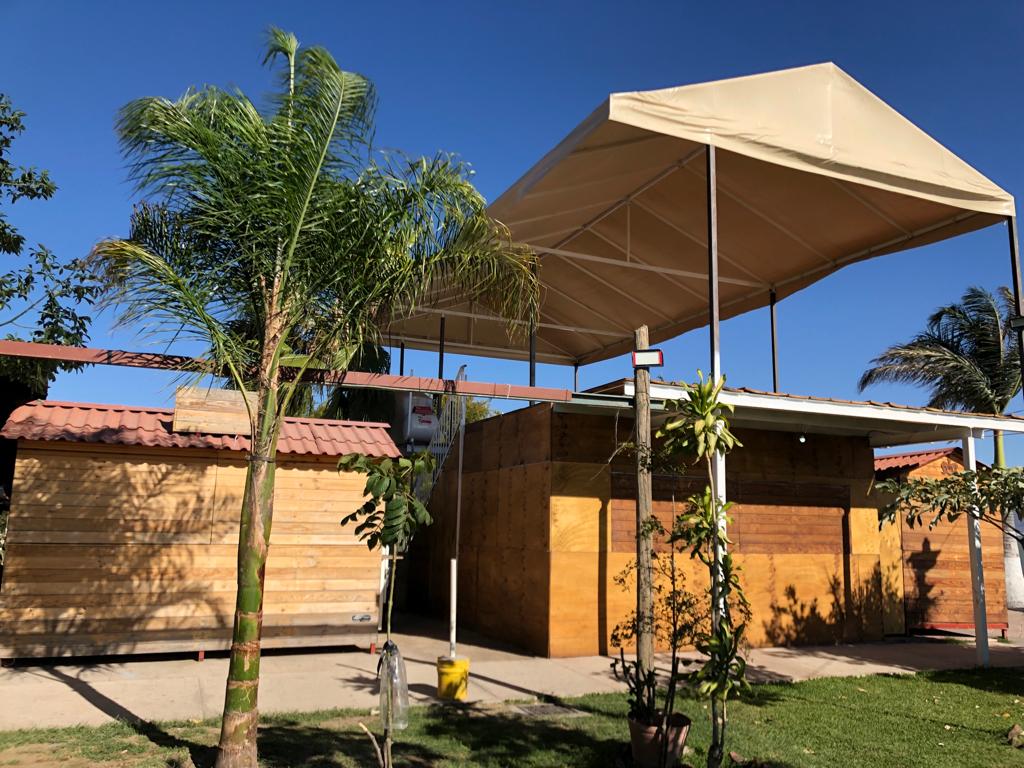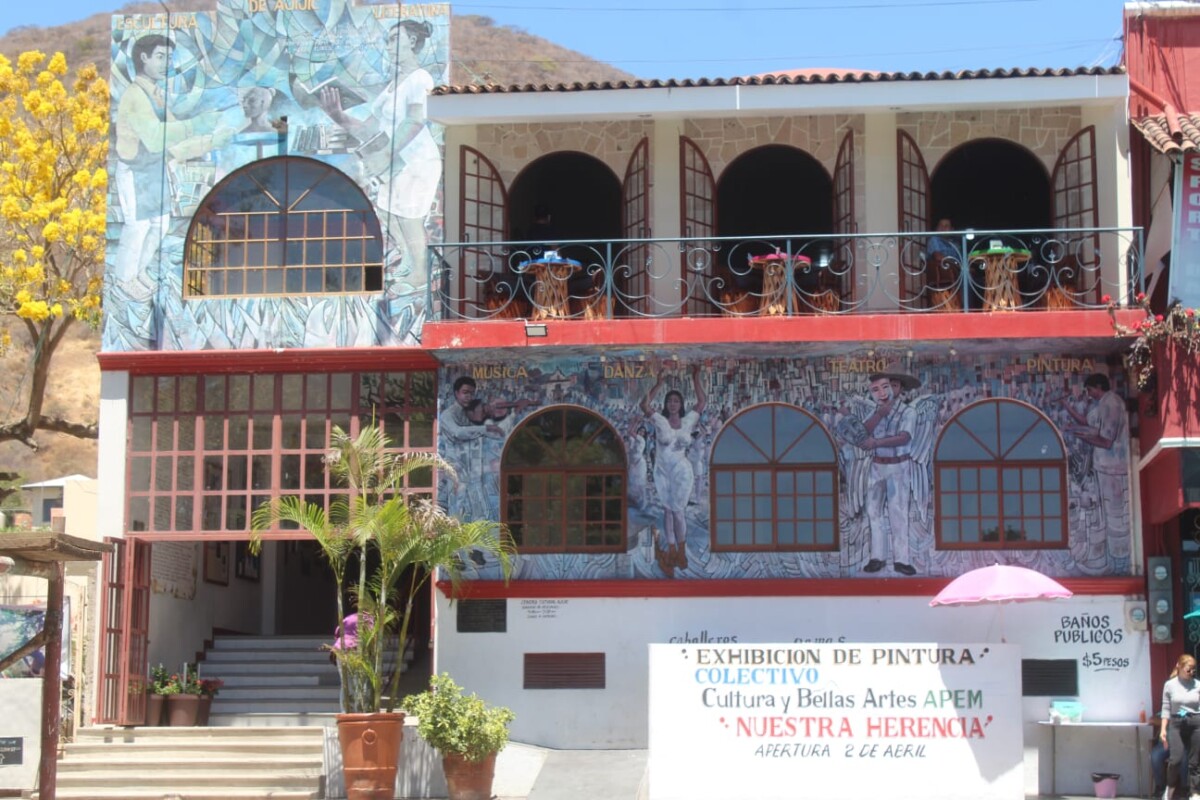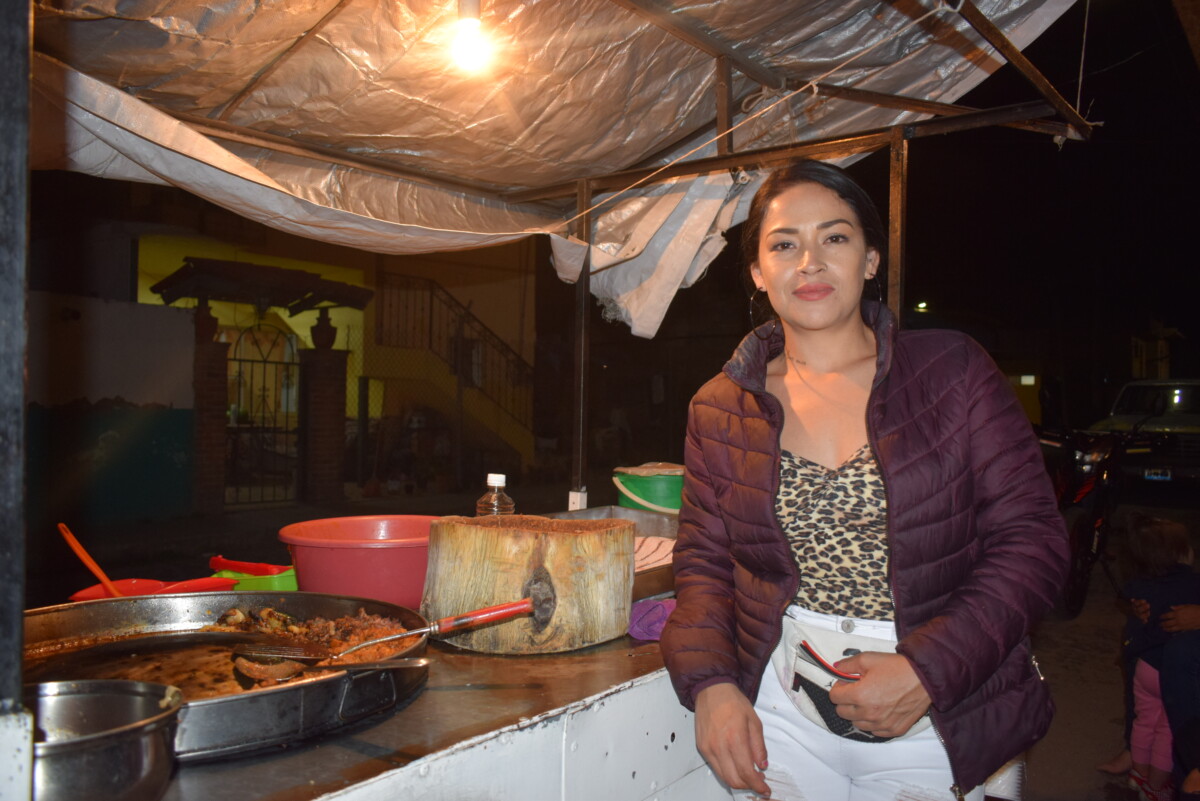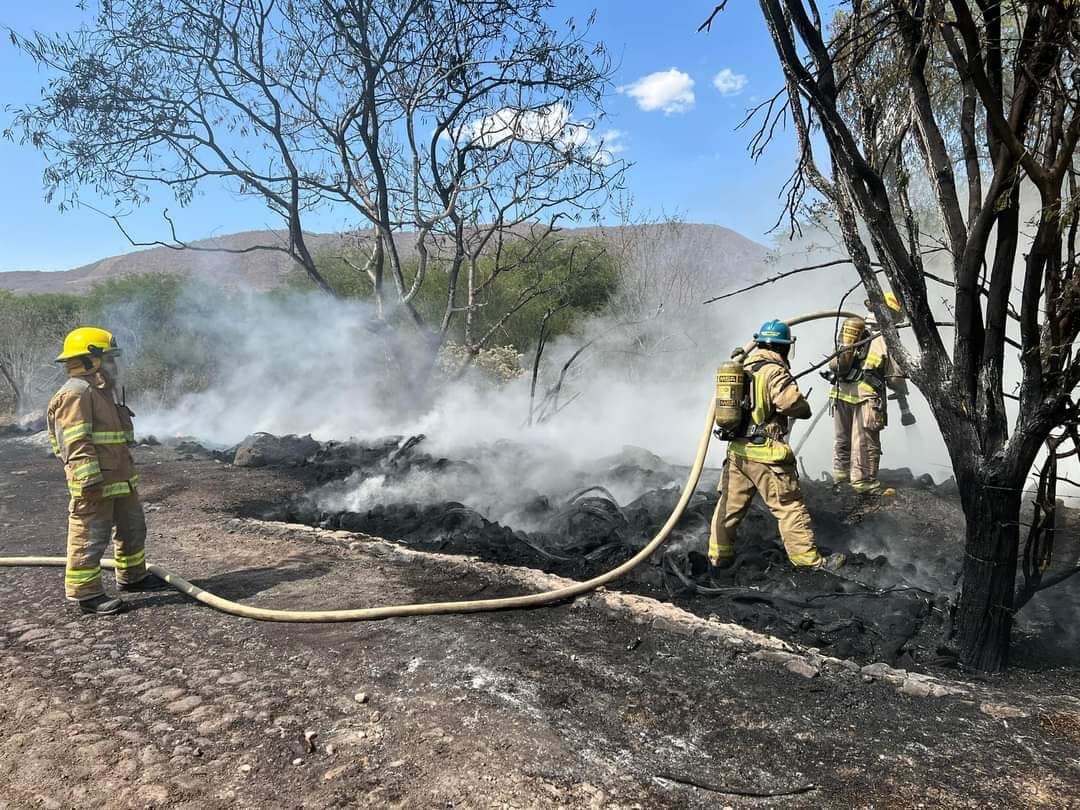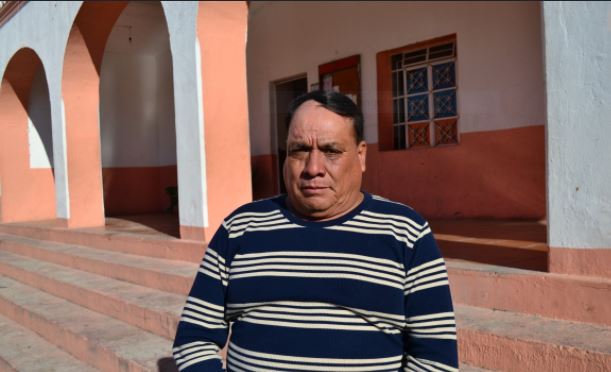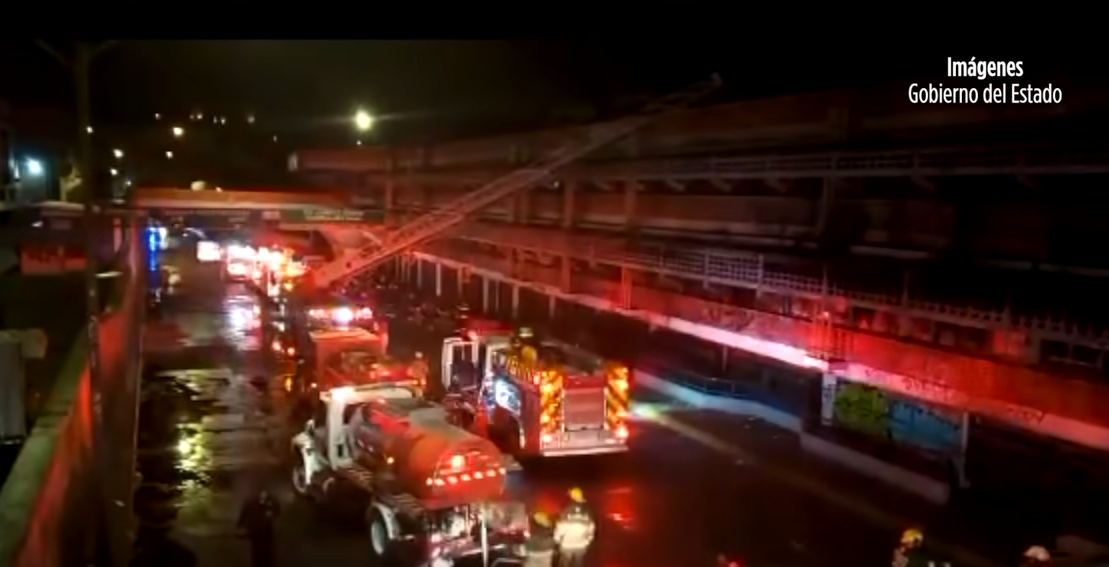en inglés
Fire in the hills of Jocotepec
Smoke was visible from several parts of the Guadalajara-Morelia highway
Editor.- A fire in the hills of Jocotepec, between the districts of El Molino and Huejotitán, generated a huge column of smoke that was visible to motorists traveling on the Guadalajara-Morelia highway on the afternoon of Wednesday, March 30.
On social networks, people commented that there were damaged wire fences, burned pasture and environmental damage, blaming the incident on people who were vandalizing the area.
At this time of the year, it is common to see an increase in rural fires. Some are generated naturally, others due to accidents caused by farmers burning plots of land, or by people who want to subdivide the hillsides.
Translated by Nita Rudy
Fire in historic San Juan de Dios market affects 430 businesses
Firefighters worked for hours. Photo: Courtesy.
Editor.- A strong fire in the Libertad market, better known as San Juan de Dios, surprised the city of Guadalajara during the early hours of Thursday, March 31, affecting 430 businesses and damaging the historic building.
Around three o’clock in the morning as the authorities realized the magnitude of the fire several metropolitan corporations of Civil Protection and Firefighter were notified. They worked intensively to gradually quench the flames.
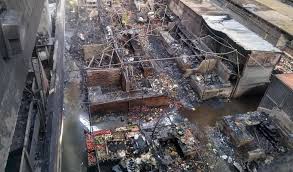
The interior of the burned market. Photo: Courtesy.
The president of Guadalajara, Pablo Lemus, went to the site of the fire Friday morning to assess the damage to the southern part of the market where food, clothing and sundries are sold. He stated that a short circuit of an illegal electric installation may have been the cause of the disaster.
The shopkeepers waited behind police barricades, uncertain as to whether their businesses were affected. When they were allowed to enter the market in small groups, tears and feelings of helplessness were evident. Many could not believe what had happened.
No injuries were reported from the incident, but there were multiple economic losses. The Government of Guadalajara and the Government of Jalisco announced that they will provide support to those who were affected.
Translated by Nita Rudy
Construction of terraces on San Juan Cosalá boardwalk authorized
Two terraces have already been installed in the commercial area of San Juan Cosalá’s boardwalk.
Héctor Ruiz Mejía (Jocotepec).- The Government of Jocotepec authorized the installation of terraces in the commercial area of the boardwalk of the San Juan Cosalá delegation.
According to local vendors, the original project proposed by the city council included «traditional» tile terraces for each one of the stores in order to homogenize the image of the establishments; however, the vendors were opposed.
The structures would have had a cost of 80,000 pesos (approximately US$4,000 or CDN$5,000), but after the merchants refused to pay that amount, the government opted to allow them to build their own terrace. «After some meetings where we refused the original project, they allowed us to make our own terraces, the only condition was that whoever had the money should start,» explained one of the merchants consulted, who preferred to remain anonymous.
The merchants are optimistic about the arrival of Holy Week, and the flow of visitors and cash that it brings with it, to assist in financing the construction of the new premises. «We have been building since last year when we started, we have been going along as we go along, little by little, as we can, we have even gone into debt, borrowing, whatever we can get, but we want to open it for Easter,» said the anonymous merchant.
Although the merchant did not specify the cost of the work, he said that the wood and the metallic structure of the platform, which will be approximately six meters wide and eleven meters long, represented a major investment, but one they hope to recover since the platform will have a capacity of 15 tables for four merchants on the upper floor.
Semanario Laguna tried to confirm this information through Jocotepec’s social communication department; however, the agency did not comment on the matter.
Translated by MaryAnne Marble
New restaurant at the Ajijic Cultural Center
The tables of the new restaurant can already be seen at the Ajijic Cultural Center. Photo: Sofía Medeles.
Sofía Medeles(Ajijic).- A space on the second floor of the Centro Cultural de Ajijic (CCA), as well as a small part of the terrace in front of the venue, has been rented to install a restaurant.
The administrator of the CCA, Héctor Hinojosa, commented that these permits and the lease were granted by the Municipality of Chapala and that this area on the second floor has been suitable for a restaurant since the building was built, with a bar and a space for kitchen furniture.
«If anyone goes to a gallery, a cultural center or an art space in the city, there is always a space designated for a cafeteria or a soda fountain. When the cultural center was built they planned in the space for this. Anyone who has visited it can see that there was always a space for the kitchen and tables,» said Hinojosa.
The administrator added that they charge 3,500 pesos for the rental of the space and that, in addition, the owner pays for the space in front of the building to place tables, which she is willing to remove when there are events.
Since it started operating last weekend, the restaurant, called «4 Estaciones (4 Seasons),» caused controversy because there were opinions against it, both for the place where it is located and for the tables that were placed outside the CCA. This space has previously had a restaurant in service.
Finally, Héctor invited those who were not in agreement to visit the place to see the quality of the food and to reflect that it is an attraction for tourists to visit the Cultural Center.
Translated by Sandy Britton
Tacos Diana: Preserving a family recipe and sustaining a family
Diana Ramos in front of her stand serving customers during the evening of Tuesday, March 29. Photo: Jazmín Stengel.
Diana Lizeth Ramos Mendoza has not only managed to provide for her three children, but also to keep alive one of the most popular recipes in Chapala.
Diana, who sells tacos in the neighborhood of La Purísima and comes from a family of merchants, married César Abrego, who was the heir to the secret adobo recipe of Tacos Don Max, located on Francisco I. Madero Avenue.
According to Diana when she was married to César, they decided to dedicate themselves to her husband’s family business. Later he went to work with his relatives, but he left her the business when they separated, which Diana took over and has been running ever since.
This is how the young woman, now 29 years old, began to familiarize herself with the process of meats, sauces and marinades. She estimates that she has been running her stand alone for about three years. “After the separation with César «I had to do it all by myself», she said.
Tacos are an important part of Mexican cuisine. Taco Day is commemorated in Mexico on March 31, since 2007. In t México the most famous tacos are: al pastor, carnitas, barbacoa, cochinita, asada, canasta, steamed, golden, placeros, stew, beef and even the governor taco, which is made with wheat flour with shrimp and Oaxaca cheese, very common in the northern coastal part of México. And of course, many other styles.
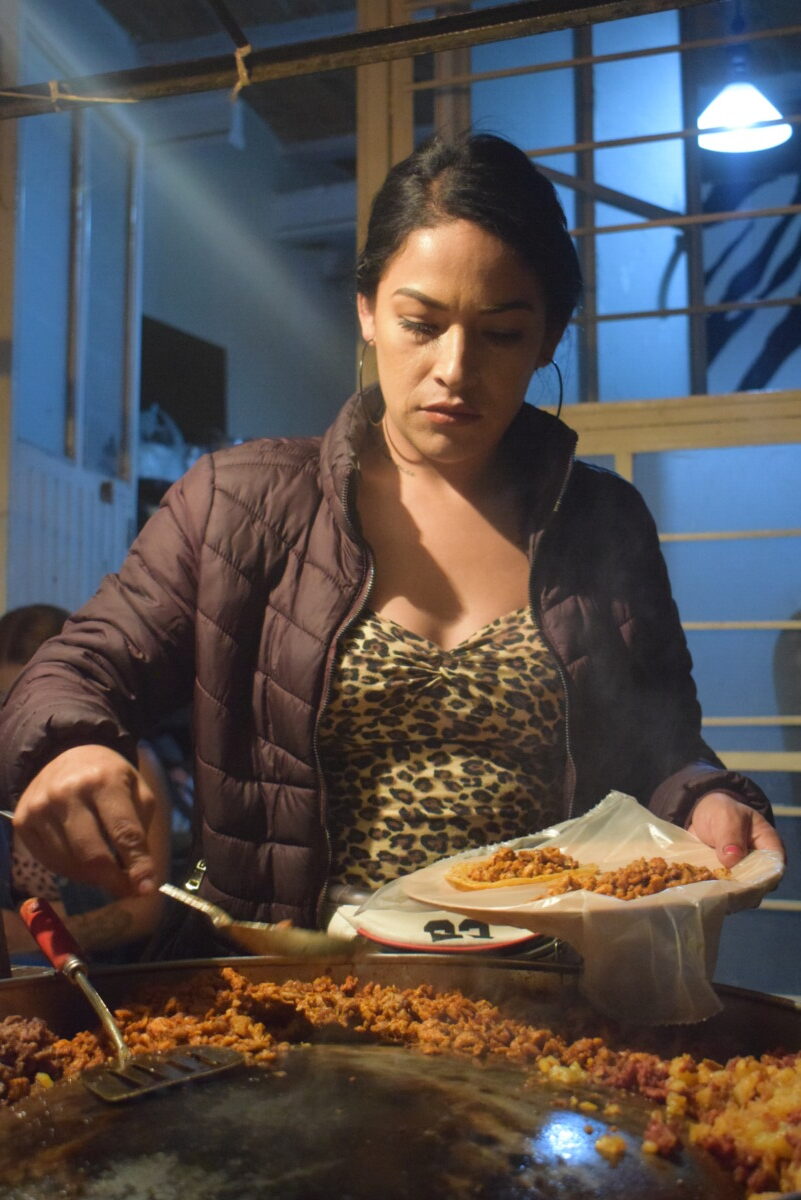
Selling tacos with the adobo recipe inherited from her ex-husband.
Diana’s daily routine consists of getting up in the morning to take her three children to school, then she takes advantage of the trip to order tortillas, buy meat and vegetables at the Chapala market.
After running the errands, she has to pick up the children from school, so Diana barely has enough time to prepare lunch for her two boys and a girl.
Her workday starts around three in the afternoon: chopping onions, cilantro and radishes, preparing the marinade, cooking the meat, vegetables and preparing the sauces. This is something Diana does five out of the seven days of the week with the help of her children.
What convinced Diana to dedicate herself to selling tacos was the ease of taking care of her children while working in front of her house. Today, Diana continues to sell adobada and papa con chorizo tacos from Saturday to Wednesday starting at 8:00 in the evening in the neighborhood of La Purisima, on Miguel Martinez Street, in front of the house marked with the number 477.
However, the low season and the increase of prices in basic foods have forced her to look for other sources of employment to help her to continue with the family tradition of selling tacos.
Translated by Sydney Metrick
Tire dump burns in Jocotepec
Firefighters bring the flames under control. Photo: JocoPiolin.
Garbage and dozens of tires burned recently in a fire on Matamoros Sur Street that caused a large column of black smoke to be visible from all over Jocotepec.
The smoke rose quickly from a property located toward the Roca Azul subdivision, so the authorities were notified. Elements of Civil Protection and Firefighters of Jocotepec arrived on the scene to control the blaze and helped prevent the fire from expanding.
Translated by Mike Rogers
Water shortage exacerbated by low water levels; Zaragoza well continues to collapse
The delegate Carlos Vázquez Reyes perceived as «normal» the shortage due to the seasonal low water level, although he acknowledged that it was aggravated by the failure in the well. Photo: File.
Alma Serrano (San Juan Cosala).- The failure of the Zaragoza well pump, together with the dry season, has left the residents of San Juan Cosalá without drinking water.
In this regard, the delegate of the town, Carlos Vázquez Reyes reported that they are already working on the resolution of the failure of the well, which last December recorded a similar failure.
«We just fixed the Zaragoza well in December 2021 and now we have the same problem as before; last time it took three months to fix,» he commented.
Although Vázquez Reyes saw the seasonal shortage as “normal,” he visualized the possibility of digging a new well to the north of the delegation, on Del Cardenal street, to solve the shortage and distribute the vital liquid in a better way.
«This problem is normal for the season because the pipes are clogged with mud and the water does not have adequate flow. Then the water stagnates in those areas and does not reach all the houses. In addition, the pump throws a lot of mud and some pipes are old,» explained the delegate.
Despite the fact that the problem has been going on for more than two months, Carlos Vázquez said that a «fair» distribution of water has been made, since they try to send it proportionally to all the houses, even at night.
Finally, the delegate informed that the corresponding authorities are already working on the failures of the Zaragoza well, although it is not known with certainty when the service will be regularized, so he asked residents to conserve the resource.
«Let’s take care of the water, if you don’t need it, please let it go to someone who does. I know that people do pay for the water, but that does not give them the right to waste it,» he concluded.
Translated by Kerry Watson
Fire severely damaged Guadalajara’s famed Mercado San Juan de Dios
Firetrucks battle blaze at Mercado San Juan de Dios in the early morning hours. Photo from governor’s office video broadcast by Grupo Reforma.
Editor. Guadalajara firemen and Jalisco Civil Protection personnel were mopping up the heavily damaged Mercado San Juan de Dios this afternoon a after they brought the raging fire that began early this morning (31 de marzo) under control The fire was first reported at 2:30 am, and according to Mayor Palo Lemus, and multiple units of the Guadalajara Bomberos and the Jalisco State Civil Protection and Fire Department responded to the report of a fire possibly in the kitchen areas (later attributed to a diablito connector used to steal electricity shorting out.). No one has been reported injured.
Mercado San Juan de Dios, designed by Alejandro Zohn and opened on December 30, 1958 in Central Guadalajara, is the largest indoor Market in Latin America with a total area of 4,000 square meter and 2980 vendor stalls.
The fire quickly spread to all four levels of the emblematic building, affecting a wide range of merchants, including clothing, shoes, arts, crafts and food. As of this afternoon 384 stalls in the mercado were reported destroyed (later raised to an estimated 430 by Civil Protection officials), according to reports from people on the scene in a video posted by Grupo Reforma. This number has not been confirmed by Laguna or official sources and may be much higher.
Javier Mina Avenue along the side of the mercado was closed as of 6:30 am and had not completely reopened as of 1:00 pm as fire crews were still mopping up and assessing the damage and the dangers in the smoking building.
Victor Roldan, General Director of the Jalisco State Civil Protection and Fire Department noted that over 300 personnel and 80 vehicles eventually were used in extinguishing the blaze. While no official assessment of damage was available as of 1:00 pm, Roldan told media that the building was not totally destroyed. Merchants were not allowed into the building because of the danger of spot fires and structural collapse, but many gathered around the security perimeter set up by fire and police, telling on-scene media that their entire livelihood may have gone up in smoke.
Mexican rock:
Gloria Rios, an American-born actress and singer, is often credited with introducing rock & roll music into México, performing in 1944 from Texas and recording in 1955 with various orchestras. She settled in with Mario Patrón and his Estrellas del Ritmo band, performing and recording covers of songs by Bill Halley and Elvis Presley.
She also recorded «La Mecedora» in 1956, which was said to be the first original song of Mexican rock & roll, although many rock historians also say that first rock and roll record ever recorded in México was “La Cama de Piedra” by Pablo Beltrán Ruíz in 1956 followed two months later by later Luis Marquez’s “Let’s Bop”.
These were not rock bands as we know them today – they were orchestras that played jazz, swing, and the “new music” with a high tempo 4/4 beat – songs like Rios’ “Jazzeando”, a fast tempo be-bop jazz tune.
The swing/jazz/rock orchestras quickly gave way to bands like Los Lunáticos in 1956 , Los Teen Tops and Las Mary Jets – an all-female Mexican Rock band formed in 1959, predating the first American female rock band Goldie & the Gingerbreads in 1964.
But unlike in the US where rock became the dominant – and highly profitable – music form until displaced by rap and hip hop, rock was repressed in México. The repression impulse was always there in a conservative society, but the 1971 two-day “Mexican Woodstock” Festival Rock y Ruedas de Avándaro, with nudity, drugs , sex and anti-government songs (imagine that?!) led to the government restricting rock music publishing and airplay.

But rock and roll cannot be held down for long, even by the Mexican government, so by the 1980’s “Los Urbanos” bands with a Bob Dylan-like folkloric style known as música rupestre, and Mexican British Invasion bands like Maná were dragging the country back into the rock revolution, centered in Monterrey.
Monterrock , a stadium-scale, anthem- style rock that sways the masses. Monterrey bands like Kinky, The Warning, Panda and many others took over Mexican arenas and stages everywhere and soon moved to Latin America and the US, and generated a second rock revolution throughout Mexico.
All of that is the foundation for the rock scene in México today which is huge, vibrant, experimental, and thrilling to watch grow and evolve. Modern Mexican rock bands like Hello Seahorse, Zoe, and Insite are popular worldwide. On the cutting edge are Mexican post-rock bands like the Guadalajara-based The Wohl Band, blending dream rock, British shoe-gaze and alt-rock into new forms. And there are the nascent upcoming bands we see here in Lakeside like Mary Island and Alfonsina.
With that rich history of Mexican rock, I am very interested in seeing the portrayal of the 60’s music at the DIF-fund raiser this Friday at the Hotel Real Chapala. Will the songs be covers of Gloria Rios, Los Lunáticos, Los Teen Tops and Las Mary Jets, or will they be straight Bill Halley and the Comets, The Drifters, and Isley Brothers. Whichever, it will be music made to dance and a lot of fun.
Governor Alfaro announced the rehabilitation of the Auditorio de la Ribera will be completed by the middle of the year
Architects and those in charge of the work, explained the works to the Governor of Jalisco, Enrique Alfaro Ramírez. Photo: Sofía Medeles.
Sofía Medeles (Ajijic).- After his March 25 tour of the Auditorio de la Ribera in Ajijic, Jalisco Governor Enrique Alfaro Ramírez, announced that the remodeling of the Auditorio will be completed in approximately 4 months.
Although previously, those in charge of the project had said that they had no date for the beginning of the third and last stage of the renovation, Alfaro Ramírez stated during his visit that it should be finished in four months and the cultural center should be up and running by the middle of this year.
«The last stage includes the entrance space, details in the auditorium and adjustments that had to be made at the end, but more than anything else, the entrance, the pond and specialized equipment,» the governor said.
He pointed out that, although 70 million pesos have already been invested in the project so far, a budget for the equipment for the center has yet to be designated.
«A budget is being developed and we are looking to involve the businesses of Chapala that offered to help. The budget will be ready in the following weeks and we will see if the private initiative will lend us a hand. Surely the equipment will also be ready within the remaining four months,» he added.
At the end of the tour of the facilities of the cultural complex, Chapala municipal president Alejandro de Jesús Aguirre Curiel, thanked the governor for the space, asserting that it will be of great importance for Ajijic, which has many talented performing artists and traditions, so it will be a good place for them to continue developing.
Also present during the governor’s visit were Alejandro Guerrero, one of the architects in charge of the project, Lourdes González Pérez, head of the state’s Culture Secretariat, and congresswomen María Dolores «Lolis» López Jara , and Claudia Murguía Torres.
The rehabilitation work began in 2020 and is part of a state project called «Cardinal Culture», which aims to develop cultural activities outside the capital of Jalisco. The auditorium will not only host artistic presentations of different disciplines, but will also host courses, as well as offices of the Jalisco Ministry of Culture.
Translated by Patrick O’Heffernan
© 2016. Todos los derechos reservados. Semanario de la Ribera de Chapala
